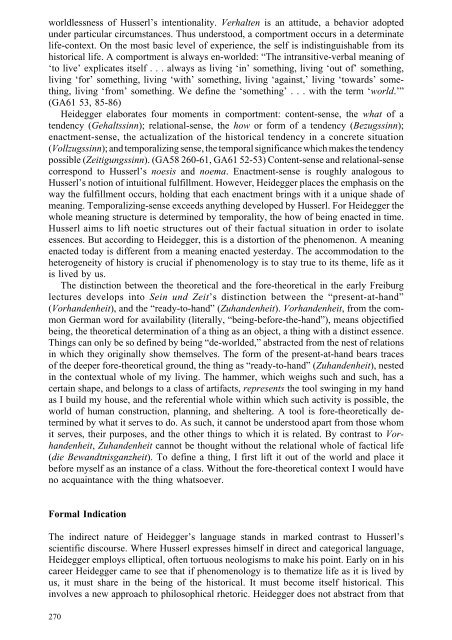[Andrzej_Wiercinski_(ed ... - WordPress.com
[Andrzej_Wiercinski_(ed ... - WordPress.com
[Andrzej_Wiercinski_(ed ... - WordPress.com
Create successful ePaper yourself
Turn your PDF publications into a flip-book with our unique Google optimized e-Paper software.
worldlessness of Husserl’s intentionality. Verhalten is an attitude, a behavior adopt<strong>ed</strong>under particular circumstances. Thus understood, a <strong>com</strong>portment occurs in a determinatelife-context. On the most basic level of experience, the self is indistinguishable from itshistorical life. A <strong>com</strong>portment is always en-world<strong>ed</strong>: “The intransitive-verbal meaning of‘to live’ explicates itself . . . always as living ‘in’ something, living ‘out of’ something,living ‘for’ something, living ‘with’ something, living ‘against,’ living ‘towards’ something,living ‘from’ something. We define the ‘something’ . . . with the term ‘world.’”(GA61 53, 85-86)Heidegger elaborates four moments in <strong>com</strong>portment: content-sense, the what of atendency (Gehaltssinn); relational-sense, the how or form of a tendency (Bezugssinn);enactment-sense, the actualization of the historical tendency in a concrete situation(Vollzugssinn); and temporalizing sense, the temporal significance which makes the tendencypossible (Zeitigungssinn). (GA58 260-61, GA61 52-53) Content-sense and relational-sensecorrespond to Husserl’s noesis and noema. Enactment-sense is roughly analogous toHusserl’s notion of intuitional fulfillment. However, Heidegger places the emphasis on theway the fulfillment occurs, holding that each enactment brings with it a unique shade ofmeaning. Temporalizing-sense exce<strong>ed</strong>s anything develop<strong>ed</strong> by Husserl. For Heidegger thewhole meaning structure is determin<strong>ed</strong> by temporality, the how of being enact<strong>ed</strong> in time.Husserl aims to lift noetic structures out of their factual situation in order to isolateessences. But according to Heidegger, this is a distortion of the phenomenon. A meaningenact<strong>ed</strong> today is different from a meaning enact<strong>ed</strong> yesterday. The ac<strong>com</strong>modation to theheterogeneity of history is crucial if phenomenology is to stay true to its theme, life as itis liv<strong>ed</strong> by us.The distinction between the theoretical and the fore-theoretical in the early Freiburglectures develops into Sein und Zeit’s distinction between the “present-at-hand”(Vorhandenheit), and the “ready-to-hand” (Zuhandenheit). Vorhandenheit, from the <strong>com</strong>monGerman word for availability (literally, “being-before-the-hand”), means objectifi<strong>ed</strong>being, the theoretical determination of a thing as an object, a thing with a distinct essence.Things can only be so defin<strong>ed</strong> by being “de-world<strong>ed</strong>,” abstract<strong>ed</strong> from the nest of relationsin which they originally show themselves. The form of the present-at-hand bears tracesof the deeper fore-theoretical ground, the thing as “ready-to-hand” (Zuhandenheit), nest<strong>ed</strong>in the contextual whole of my living. The hammer, which weighs such and such, has acertain shape, and belongs to a class of artifacts, represents the tool swinging in my handas I build my house, and the referential whole within which such activity is possible, theworld of human construction, planning, and sheltering. A tool is fore-theoretically determin<strong>ed</strong>by what it serves to do. As such, it cannot be understood apart from those whomit serves, their purposes, and the other things to which it is relat<strong>ed</strong>. By contrast to Vorhandenheit,Zuhandenheit cannot be thought without the relational whole of factical life(die Bewandtnisganzheit). To define a thing, I first lift it out of the world and place itbefore myself as an instance of a class. Without the fore-theoretical context I would haveno acquaintance with the thing whatsoever.Formal IndicationThe indirect nature of Heidegger’s language stands in mark<strong>ed</strong> contrast to Husserl’sscientific discourse. Where Husserl expresses himself in direct and categorical language,Heidegger employs elliptical, often tortuous neologisms to make his point. Early on in hiscareer Heidegger came to see that if phenomenology is to thematize life as it is liv<strong>ed</strong> byus, it must share in the being of the historical. It must be<strong>com</strong>e itself historical. Thisinvolves a new approach to philosophical rhetoric. Heidegger does not abstract from that270


